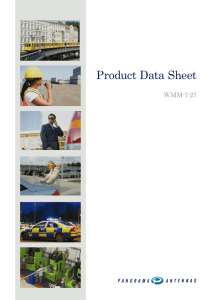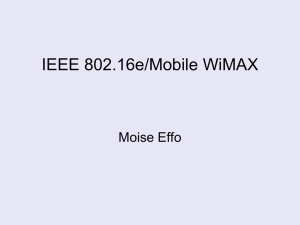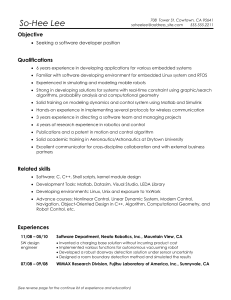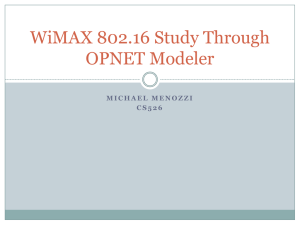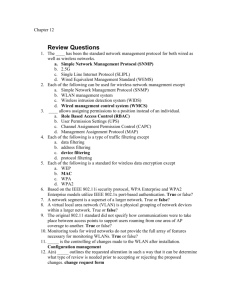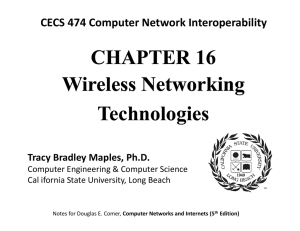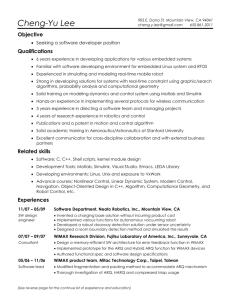Performance Analysis of Space Time Coded MIMO Mobile Wimax
advertisement
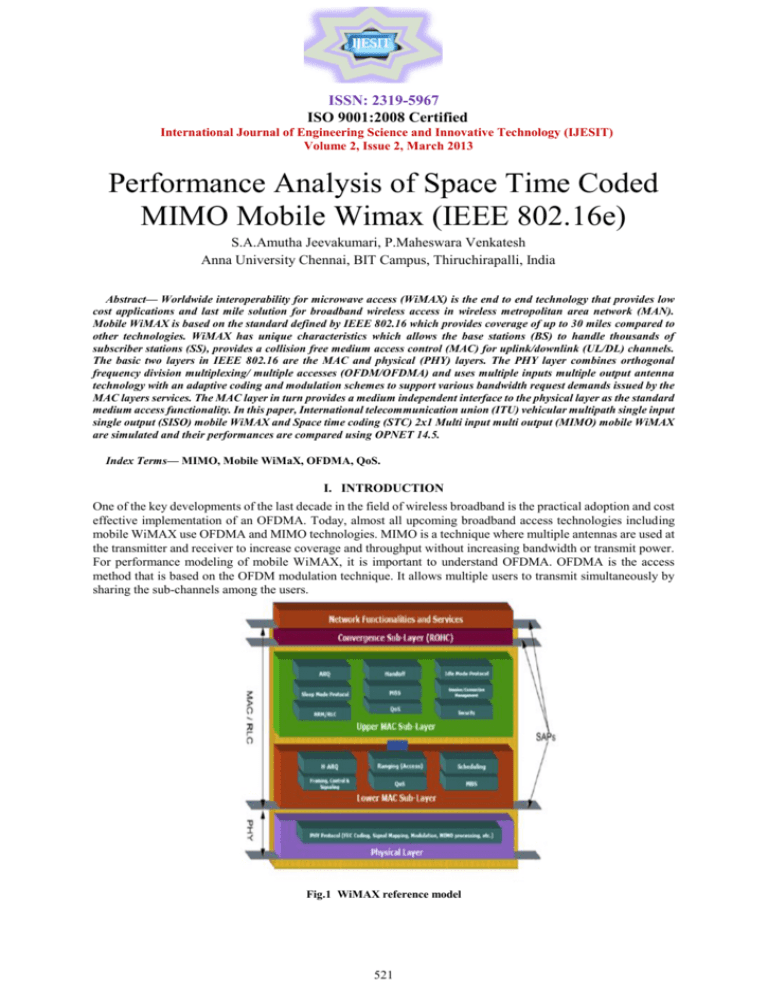
ISSN: 2319-5967 ISO 9001:2008 Certified International Journal of Engineering Science and Innovative Technology (IJESIT) Volume 2, Issue 2, March 2013 Performance Analysis of Space Time Coded MIMO Mobile Wimax (IEEE 802.16e) S.A.Amutha Jeevakumari, P.Maheswara Venkatesh Anna University Chennai, BIT Campus, Thiruchirapalli, India Abstract— Worldwide interoperability for microwave access (WiMAX) is the end to end technology that provides low cost applications and last mile solution for broadband wireless access in wireless metropolitan area network (MAN). Mobile WiMAX is based on the standard defined by IEEE 802.16 which provides coverage of up to 30 miles compared to other technologies. WiMAX has unique characteristics which allows the base stations (BS) to handle thousands of subscriber stations (SS), provides a collision free medium access control (MAC) for uplink/downlink (UL/DL) channels. The basic two layers in IEEE 802.16 are the MAC and physical (PHY) layers. The PHY layer combines orthogonal frequency division multiplexing/ multiple accesses (OFDM/OFDMA) and uses multiple inputs multiple output antenna technology with an adaptive coding and modulation schemes to support various bandwidth request demands issued by the MAC layers services. The MAC layer in turn provides a medium independent interface to the physical layer as the standard medium access functionality. In this paper, International telecommunication union (ITU) vehicular multipath single input single output (SISO) mobile WiMAX and Space time coding (STC) 2x1 Multi input multi output (MIMO) mobile WiMAX are simulated and their performances are compared using OPNET 14.5. Index Terms— MIMO, Mobile WiMaX, OFDMA, QoS. I. INTRODUCTION One of the key developments of the last decade in the field of wireless broadband is the practical adoption and cost effective implementation of an OFDMA. Today, almost all upcoming broadband access technologies including mobile WiMAX use OFDMA and MIMO technologies. MIMO is a technique where multiple antennas are used at the transmitter and receiver to increase coverage and throughput without increasing bandwidth or transmit power. For performance modeling of mobile WiMAX, it is important to understand OFDMA. OFDMA is the access method that is based on the OFDM modulation technique. It allows multiple users to transmit simultaneously by sharing the sub-channels among the users. Fig.1 WiMAX reference model 521 ISSN: 2319-5967 ISO 9001:2008 Certified International Journal of Engineering Science and Innovative Technology (IJESIT) Volume 2, Issue 2, March 2013 This technique optimizes the use of spectrum resources and enhances indoor coverage by assigning a robust scheme to vulnerable links. Reserved for monitoring the quality of the channel (pilot sub carriers), for providing (guard sub carriers) between the channels, or for using as a reference frequency (DC subcarrier). The WiMAX MAC layer uses the PHY layer to transmit higher level packet traffic in one of three operational modes: point to point (PPP), point to multi-point (PMP) and mesh. In PMP, BS services all mobile stations (MS). All MS to MS communications are handled by the BS. In contrast, the mesh mode allows stations to communicate directly. The MAC services and responsibilities are distributed across several sub-layers as shown in Fig. 1 known as the service specific convergence sub-layer (CS) and the common part sub-layer (CPS) [1]. The main issue addressed for the PHY layer is to allocate the resources efficiently by assigning a set of subcarriers and by determining the number of bits to be transmitted for each subcarrier in an OFDMA system The rest part of this paper is organized as follows. Section 2 discusses the QoS support in MAC layer of mobile WiMaX, section 3 elaborate the simulation model, section 4 briefs the simulation results and section 5 concludes this paper. II. QOS SUPPORT IN MAC LAYER The most important part of the MAC layer design that distinguishes WiMAX from all other broadband wireless standards is its support for QoS classes [2]. MAC architecture provides a connection oriented architecture which helps achieving a good control of QoS, where the BS is responsible for controlling all downlink and uplink connections. A certain set of QoS parameters could be associated with a service flow which is a unidirectional flow of packets identified by a service flow identifier (SFID) [3]. WiMAX has five classes of flows, each having different QoS requirements, and these are: Unsolicited Grant Service (UGS), Real-Time Polling Service (rtPS), non-Real-Time Polling Service (nrtPS), Enhanced-Real-Time Polling Service (ertPS), and best effort (BE). Table 1. Show a brief description of each service class and their QoS requirement. Also for each class’s uplink connections, the type of service specifies which mechanisms to use in order to request bandwidth. UGS support applications that require stringent delay requirements with fixed data packet on a periodic manner such as VoIP. The UGS service doesn’t request bandwidth instead bandwidth for uplink is granted regardless of the channel quality estimate hence, UGS connections use the unsolicited granting bandwidth request. A periodic bandwidth is granted for any UGS service class without any polling or contention. The bandwidth granted to each UGS service is determined by the BS as the average of lowest amount of data transmitted on the connection when over time. SS may ask the BS to poll it to additional allocated bandwidth if it needs more bandwidth. Real-time polling service rtPS is designed to support applications with less delay requirements and has variable size data frames at periodic intervals, such as video streaming of (MPEG) video and streaming audio applications. In rtPS connection the QoS guarantees it supports are a minimum reserved bandwidth with an upper threshold for waiting times for each packet at the MAC layer and a minimum latency. TABLE I:QOS CLASSES SUPPORTED BY WIMAX MAC LAYER Servic Descriptions Applications e UGS For Constant bit rate VOIP (CBR) and delay dependant applications rtPs For variable rate and Streaming audio, streaming delay dependant video applications ertPs For variable rate and Voice with silence suppresion delay dependant applications nrtps Variable rate and FTP non real time applications BE Best effort E-mail, web traffic Unlike the UGS, packet sizes in rtPS are of variable length and a SS is required to inform the BS of its current bandwidth at the time of service request. For each rtPS connection the BS grants unicast polls every polling interval specified by QoS parameters. nrtPS and BE are used with applications which doesn’t have any strict delay 522 ISSN: 2319-5967 ISO 9001:2008 Certified International Journal of Engineering Science and Innovative Technology (IJESIT) Volume 2, Issue 2, March 2013 requirements. nrtPS is used with application that requires a minimum data rate, like File Transfer Protocol (FTP) while BE doesn’t need minimum data rate requirement as an example is HTTP and email applications nrtPS and BE uses piggybacking to embed the bandwidth request into an uplink PDU or by replying to a broadcast poll initiated by the base station which is in a contention based basis [4]. An important and very challenging function of the WiMAX system is the support of various advanced antenna techniques, which are essential to provide high spectral efficiency, capacity, system performance, and reliability: Beam forming using smart antennas provides additional gain to bridge long distances or to increase indoor coverage; it reduces inter-cell interference and improves frequency reuse, Transmit diversity and MIMO techniques using multiple antennas take advantage of multipath reflections to improve reliability and capacity. Smart antenna technologies typically involve complex vector or matrix operations on signals due to multiple antennas [5]. OFDMA allows smart antenna operations to be performed on vector flat sub-carriers. Complex equalizers are not required to compensate for frequency selective fading. OFDMA therefore, is very well-suited to support smart antenna technologies. In fact, MIMO-OFDM/OFDMA is envisioned as the corner-stone for next generation broadband communication systems. Mobile WiMAX supports a full range of smart antenna technologies to enhance system performance. The smart antenna technologies supported include: - Beam forming. With beam forming, the system uses multiple-antennas to transmit weighted signals to improve coverage and capacity of the system and reduce outage probability. - Space-Time Code (STC). Transmit diversity such as Alamouti code is supported to provide spatial diversity and reduce fade margin [6-8]. - Spatial Multiplexing (SM). Spatial multiplexing is supported to take advantage of higher peak rates and increased throughput. With spatial multiplexing, multiple streams are transmitted over multiple antennas. If the receiver also has multiple antennas, it can separate the different streams to achieve higher throughput compared to single antenna systems. With 2x2 MIMO, SM increases the peak data rate two-fold by transmitting two data streams. In UL, each user has only one transmit antenna, two users can transmit collaboratively in the same slot as if two streams are spatially multiplexed from two antennas of the same user [ 9,10]. This is called UL collaborative SM. III. SIMULATION MODEL OPNET Modeler simulation tool has widespread adoption in both commercial and military domains. The adopted model topology is comprised of a Mobile WiMAX access network connected to the Internet via a 155.52 Mbps OC-3 PPP link. In the proposed simulation model, the objective measures used in video content performance analysis employed were packet loss, throughput, and signal to noise ratio (SNR). Packet loss is the number of corrupted, lost, or delayed packets divided by the total number of packets expected at the video client station. Throughput is defined as the traffic load that the media stream will impress upon the network. It can be measured in bytes/s (Bps) or bits/s (bps). For constant bit rate (CBR) content, the throughput is constant. SNR is the ratio between signal to noise power. The OPNET mobile WiMAX scenario created for simulation is shown in Fig. 2. The advanced antenna system (AAS) parameter values were limited to the two supported schemes in the OPNET Modeler. A SISO scheme describes a basic station configuration with one transmitter and one receiver. A 2 x 1 MIMO system is also modeled using STC to exploit the independent fading characteristics in a multiple-antenna system configuration to increase coverage. In order to include link propagation delays and PHY behavior across varying distances between the Mobile WiMAX client and base stations, a global coordinate system was adopted to describe node locations using latitude, longitude, and elevation. The WiMAX gateway router is approximately 3350 km from the IDC, which introduces a propagation delay of approximately 13.3 ms in each direction. Fig. 3 shows the WiMAX SISO scenario in which one BS serves many SS, the WiMax model efficiency mode is physical layer enabled, number of transmitter is set to SISO in BS, Fig. 4 Shows the WiMAX MIMO scenario in which same attributes are used but the number of transmitters is STC 2x1 MIMO. 523 ISSN: 2319-5967 ISO 9001:2008 Certified International Journal of Engineering Science and Innovative Technology (IJESIT) Volume 2, Issue 2, March 2013 Fig. 2. OPNET WiMAX scenario Fig. 3. WiMAX SISO scenario Fig. 4. WiMAX MIMO scenario Fig. 5. Throughput for SISO and MIMO 524 ISSN: 2319-5967 ISO 9001:2008 Certified International Journal of Engineering Science and Innovative Technology (IJESIT) Volume 2, Issue 2, March 2013 IV. SIMULATION RESULTS The system parameters for SISO and MIMO system simulated using OPNET Modeler 14.5 are presented in this section. In Fig. 5 throughput of the two system is compared which shows that the performance of MIMO system provides better throughput than SISO system configuration. Signal to noise ratio (SNR) of the two systems is shown Fig. 6, which shows that the SNR of MIMO system is comparatively better than SISO system configuration. It may be understood from the result that the SNR maintains very good region of 5 to 13 db for MIMO mobile WiMaX system, where as it occupies the vast region of 6 – 16 db in the SISO mobile WiMaX Fig. 7 shows simulation results meant for the packet loss of SISO and STC 2X1 MIMO systems, in which the packet loss in the MIMO mobile WiMaX system is relatively lesser than that of SISO WIMAX. Fig. 6. SNR for SISO and MIMO Fig. 7. Packet loss for SISO and MIMO V. CONCLUSION This paper discusses the performance of International telecommunication union (ITU) vehicular multipath single input single output (SISO) mobile WiMAX and Space time coding (STC) 2x1 Multi input multi output (MIMO) mobile WiMAX simulated with OPNET 14.5, The performance of MIMO system provides better result than SISO system configuration. The simulation results indicate that Mobile WiMAX can deliver sufficient performance with MIMO system configuration. While simulations do not guarantee real world equivalence, these results are encouraging and reveal that Mobile WiMAX is a formidable player in fourth generation networks. Thus, our future 525 ISSN: 2319-5967 ISO 9001:2008 Certified International Journal of Engineering Science and Innovative Technology (IJESIT) Volume 2, Issue 2, March 2013 work is to use of overhead reducing mechanisms and proper scheduling that may significantly improve network performance. REFERENCES [1] Will Hrudey, Ljiljana Trajković, “MOBILE WIMAX MAC AND PHY LAYER OPTIMIZATION FOR IPTV”, Mathematical and Computer Modeling, Elsevier Science Publishers , Pages 2119-2135, Volume 53 Issue 11-12, June, 2011. doi:10.1016/j.mcm.2010.08.008. [2] Chakchai So-In, Raj Jain, and Abdel-Karim Tamimi, “CAPACITY EVALUATION FOR IEEE 802.16E MOBILE WIMAX” JOURNAL OF COMPUTER SYSTEMS, NETWORKS AND COMMUNICATIONS”, vol. 1, no. 1, April 2010. [3] Arathi.R.Shankar, Adarsh Pattar and V.Sambasiva Rao, “QUALITATIVE ANALYSIS OF THE QOS PARAMETERS AT THE LAYER 1 AND 2 OF MOBILE WIMAX 802.16E”, International Journal of Wireless & Mobile Networks (IJWMN) Vol. 4, No. 2, April 2012, DOI: 10.5121/ijwmn.2012.4205. [4] Manal Al-bzoor and Khaled Elleithy, “WIMAX BASICS FROM PHY LAYER TO SCHEDULING AND MULTICASTING APPROACHES”, International Journal of Computer Science & Engineering Survey (IJCSES) Vol.2, No.1, Feb 2011. [5] Raj jain, Chakchai so-in and Abdel-karim al tamimi, “SYSTEM-LEVEL MODELING OF IEEE 802.16E MOBILE WIMAX NETWORKS: KEY ISSUES”, IEEE Wireless Communications, pp. 73-79, October 2008. [6] Md. Ashraful Islam and Riaz Uddin Mondal, “Performance Evaluation of Wimax Physical Layer under Adaptive Modulation Techniques and Communication Channels”, (IJCSIS) International Journal of Computer Science and Information Security, Vol. 5, No.1, 2009. [7] Mohamed, M.A, Abo-El-Seoud, M.S and Abd-El-Atty, H.M, “Performance simulation of IEEE 802.16e WiMAX physical layer”, proceedings of international IEEE conference on Information Management and Engineering (ICIME), Page(s): 1 – 13 , 16-18 April 2010, 10.1109/ICIME.2010.5478148. [8] Patidar, M. Dubey, R, Jain, N.K. and Kulpariya, S. , “Performance analysis of WiMAX 802.16e physical layer model”, proceedings of international IEEE conference on Wireless and Optical Communications Networks (WOCN), Page(s): 1 – 4, 20-22 Sept. 2012. [9] Ji Hoon Lee, Sangheon Pack, Taekyoung Kwon and Yanghee Choi, “Reducing Handover Delay by Location Management in Mobile WiMAX Multicast and Broadcast Services”, IEEE Transactions on Vehicular Technology, Volume: 60 , Issue: 2 , Page(s): 605 – 617, 2011. 10.1109/TVT.2010.2096831. [10] Jae-Young Pyun, DongYou Choi, Sun-Kuk Noh and Goo-Rak Kwon, “OFDMA channel aware error-resilient mobile streaming video service over mobile WiMAX”, IEEE Transactions on Consumer Electronics, Page(s): 68 - 75, Volume: 57 , Issue: 1 10.1109/TCE.2011.5735483. 526
